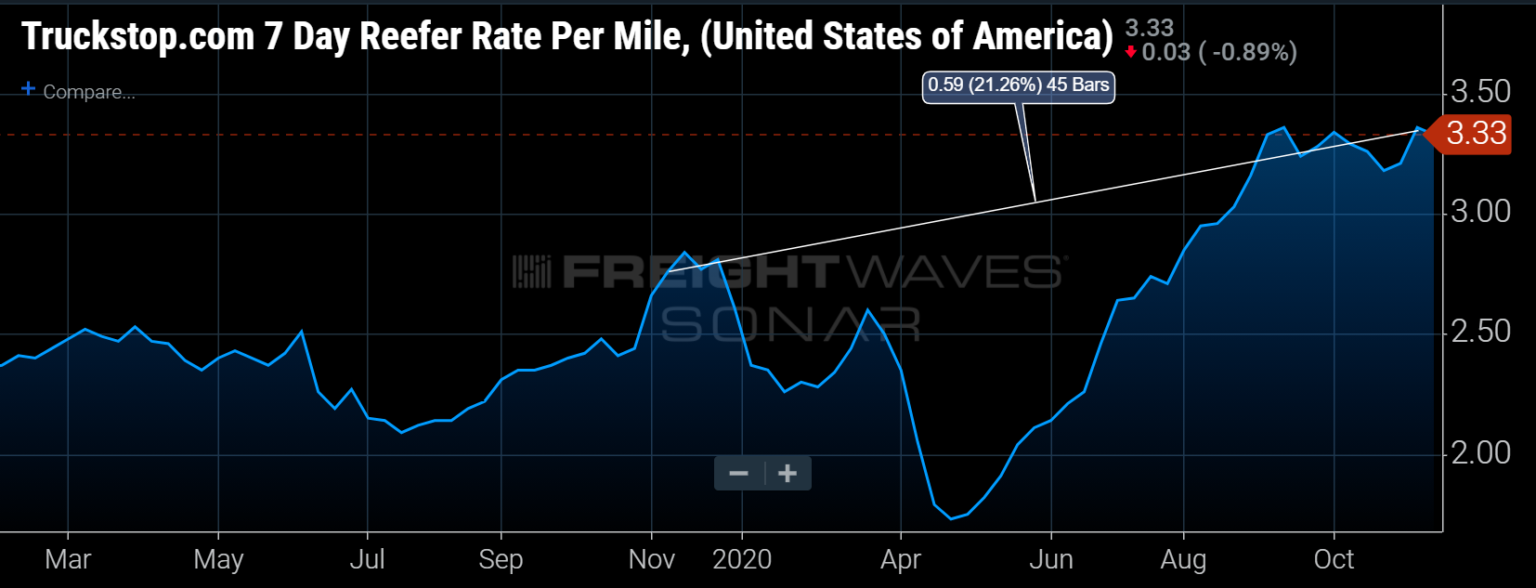The national reefer — industry slang for temperature-controlled trailers — rejection index (ROTRI) topped 48% for the first time since the index’s creation this week, which could move even higher once the vaccine for COVID-19 begins being distributed in the coming months. This means that shippers that utilize temperature-controlled equipment should be prepared to continue paying premiums for this service for the foreseeable future.

FreightWaves’ tender rejection indexes measure the rates at which carriers decline to move a truckload electronically submitted by their customers. The higher this value goes, the odds that shippers will need to pay more for capacity increase. There is also a connection between declining service and increasing rejection rates as well, seeing as it is a measure of carrier compliance. Currently, about one out of every two reefer loads submitted is being turned down by carriers.
Reefer capacity, which tends to cost about 10% more per load on average than its dry van counterpart, has become even more divergent over the past three months. From May 1 until the middle of August, reefer rejection rates increased at a similar pace to dry van tender rejections — climbing an average of 29 basis points (bps) per day compared to van’s 22.
From Aug. 18 to Sept. 7, the relationship ROTRI averaged a 55 bps-per-day rise compared to dry van slowing to 11 bps per day. Both modes continue to experience historical tightness, but reefer capacity is of increasing importance as pharmaceutical providers Pfizer (NYSE: PFE) and Moderna (NASDQ: MRNA) are closing in on being able to distribute their COVID-19 vaccines.

The trucking industry has been somewhat insulated from the negative economic impacts of the pandemic, as trucking volumes recovered faster than many expected thanks largely to increased consumer demand for durable goods while spending more time at home. This has pushed trucking spot rates over 20% higher year-over-year for reefer loads.
During the initial U.S. outbreak in March, demand for trucking capacity skyrocketed as consumers purchased items to prepare for sheltering in place. Reefer rejection rates jumped from 10% to 28% in two weeks before falling back under 4% a month later. Capacity has been tightening ever since.
While the tight capacity may not be a direct concern for vaccine distribution efforts, it should be for shippers that move freight on temperature-controlled equipment. The vaccine will be largely moved on smaller equipment than the 53-foot trailers that the reefer rejection index measures, but that also means fewer alternatives for shippers who rely on that distribution channel.
Transportation providers know vaccine distribution is the highest priority and they will be well compensated for its transport, which means other commodities will be pushed down the already tall priority ladder. This will also impact dry van capacity as shippers can utilize reefer backhaul lanes at a discount sometimes, meaning some of them will lose their providers if they already haven’t.
With capacity already stretched to its limit and COVID cases back on the rise, reefer demand will remain strong for the winter months. I think we can all agree that paying a little more for transportation in order to get a vaccine and put COVID-19 in the rearview mirror will be worth it.










